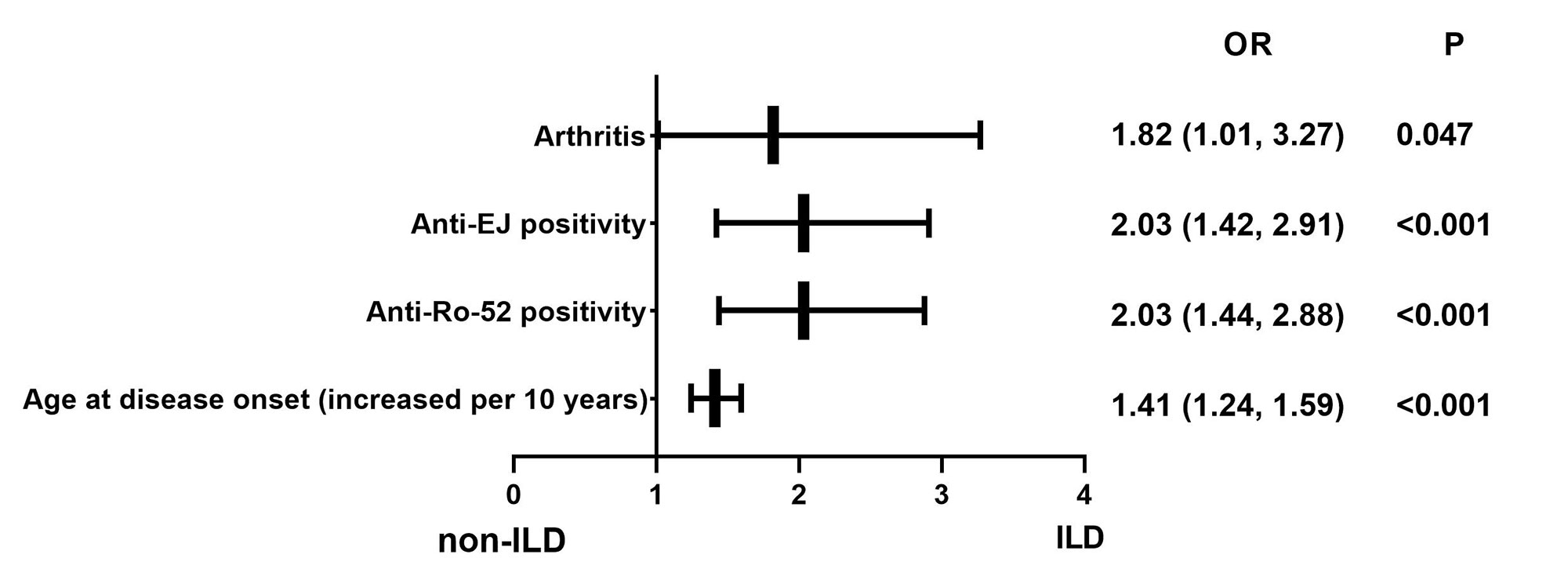Session Information
Session Type: Poster Session D
Session Time: 1:00PM-3:00PM
Background/Purpose: Based on the Chinese Rheumatology Data Center Inflammatory Myopathy Registry (CRDC-MYO), this study aimed to describe the baseline characteristics of a subgroup of patients with anti-synthetase syndrome (ASS), and to explore the risk factors associated with the prevalence of interstitial lung disease (ILD) in ASS patients.
Methods: ASS patients, who were registered in the CRDC-MYO from September 2012 to January 2022, were included in the present study. The baseline data at the time of enrollment were collected, including the demographic, clinical and laboratory characteristics, and treatment regimen as well. The risk factors of ILD in ASS patients were analyzed by multivariable logistic regression.
Results: This study included 750 ASS patients from 114 clinical center around China, 577 (76.9%) of whom were female. The average age at disease onset was (48.2±14.4) years old. The most common clinical manifestations were myositis (77.2%), rash (76.3%), mechanic hands (70.4%), and ILD (70.3%). Anti-Jo-1 antibody was the most common anti-synthetase antibody (61.4%), followed by anti-PL-7 antibody (25.0%), anti-EJ antibody (15.3%), and anti-PL-12 (12.1%). Anti-Ro-52 antibody was the most common myositis-associated antibody (70.9%). 90.8% of ASS patients received glucocorticoid therapy, and the most common immunosuppressant was cyclophosphamide, followed by tacrolimus (13.4%) and cyclosporine A (9.4%). The average forced vital capacity was 74.3±17.5%, the average forced expiratory volume in the first second was 74.3±17.9%, while diffusing capacity of the lungs for carbon monoxide was 58.8±18.8%. The most common HRCT ILD pattern was non-specific interstitial pneumonia (59.2%). The independent risk factors associated with ILD included: older age at disease onset, anti-EJ and anti-Ro-52 positivity, and arthritis.
Conclusion: This study describes the cross-sectional characteristics of a so-far largest Chinese multi-center ASS cohort. The risk factors of ILD identified in ASS patients provides evidence for the early screening and diagnosing of ASS related ILD.
To cite this abstract in AMA style:
tang m, Wang Q, Wei w, Yang P, Duan X, Li H, Wu C, ZHAO J, shi j, Leng X, Tian X, LI M, Zhao Y, Zeng X. A Multi-center Clinical Cohort Study of Chinese Anti-synthetase Syndrome Patients [abstract]. Arthritis Rheumatol. 2022; 74 (suppl 9). https://acrabstracts.org/abstract/a-multi-center-clinical-cohort-study-of-chinese-anti-synthetase-syndrome-patients/. Accessed .« Back to ACR Convergence 2022
ACR Meeting Abstracts - https://acrabstracts.org/abstract/a-multi-center-clinical-cohort-study-of-chinese-anti-synthetase-syndrome-patients/

